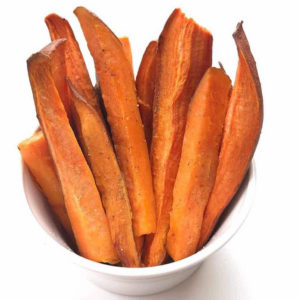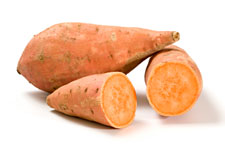
Take a look at some fun facts and delicious ideas to include the superfood sweet potato in your meals.
Sweet potatoes can be more than just a Thanksgiving favorite prepared with extra fat and sugar. They are a naturally sweet treat that delivers a lot of nutrition all year round. Simply prepared—mashed, baked, folded into pancakes, or made into guilt-free baked fries—sweet potatoes are a nourishing addition to any meal. That orange flesh is a give away that these root vegetables are bursting with carotenoids.
Superfood Sweet Potato Nutrition Information
One medium potato (5” long and 2” wide—about the size of a computer mouse) provides 103 calories, 4 grams fiber, 2 grams of protein, over 100% of kids daily vitamin A and loads of vitamin C. It also contains the “fight-o-nutrients” called carotenoids. As though that weren’t enough, they’re also a great source of vitamin C, potassium, and fiber, with smaller amounts of vitamin B6, manganese, copper, and iron.
What are carotenoids, and what are their benefits?
Carotenoids are a type of antioxidant—a naturally occurring chemical that prevents cells from being damaged. There are over 600 carotenoids, all packed with disease-fighting properties. New research shows carotenoids may also help ward off Alzheimer’s and the alpha- and beta-carotene (two types of carotenoids) in sweet potatoes may reduce the risk of breast cancer. They also promote eye health. Remember, disease prevention starts at a young age, so it’s never too early to eat healthily!
Does the color of my sweet potato matter?
Sweet potato flesh and skins can come in different colors—white, yellow, orange, red, and purple —which each have different phytochemicals. This means that any sweet potato you choose will have powerful plant compounds.
What’s the difference between a regular sweet potato and a purple sweet potato?
The rarer purple variety has anthocyanins, a type of flavanoid, also an antioxidant, which may inhibit certain types of cancers. Flavonoids can also help reduce the risk of developing heart disease and decrease memory loss. Regular sweet potatoes still have powerful phytochemicals due to their orange color, but switching it up every once in a while with purple sweet potatoes can give you even more benefits! Have the kids go on a hunt in the supermarket or farmer’s market and see how many varieties they can find.
Are sweet potatoes anti-inflammatory?
Chronic inflammation is definitely something we aim to avoid since it can lead to many of the health problems we see today, including cancer, heart disease, and diabetes. The good news is that sweet potatoes can help to fight inflammation in our bodies! They are known to be a good source of choline, which has been found to be associated with decreased inflammation. (1) Those anthocyanins in purple sweet potatoes have also been found to be fighters against inflammation. (2) Just another reason to enjoy sweet potatoes all year round!
What’s the difference between yams and sweet potatoes?
You may have heard there’s a difference between sweet potatoes and yams. This is true. The difference is sweet potatoes are a root vegetable, whereas yams are tubers—a thickened part of the stem. See if you can tell the difference without looking at the label!
How often should I eat them?
MyPlate recommendations are to make half of your kids plates fruits and vegetables. Orange foods like sweet potatoes fit the bill—as do carrots, papaya, mangos, cantaloupe, and butternut squash. Find ways to experiment with all colors of food. Variation can help avoid monotony and bored taste buds! Sweet potatoes are one of our favorites because of their versatility. Looking for more ways to eat sweet potato? Check out our plant-based boost cookbook.
How do I choose my sweet potato?
Sweet potatoes should be firm and free of bruises or soft spots. Store them in a cool dry place with adequate airflow. The size of the sweet potato may make a difference for you as well. How many people are you cooking for, and how are you preparing the sweet potatoes? Smaller ones are easier to serve as whole potatoes when you’re making loaded sweet potatoes. Have your kids choose their own when you’re making a grocery run. No matter which one you get, you and your kids will be surprised by its natural sweetness.
How to cook a sweet potato in the microwave
The size of your sweet potato may vary the cooking times. To start, wash the surface of your sweet potato. Then pat dry. For a medium-sized sweet potato, puncture it with a fork evenly throughout the whole surface, about 4-6 times. Put it on a microwave-safe plate, and microwave for 2½ minutes. Flip over and microwave for another 2½ minutes. Check to see if your fork or knife easily pierces the sweet potato. If not, microwave again for another 30 seconds, and repeat after checking each time until you reach the desired consistency. Your sweet potato will be hot, so be cautious when taking it out of the microwave!
What are some new ways to prepare sweet potatoes?
Forget candied yams that typically have added sugar and saturated fat. You can substitute sweet potatoes wherever you would use white ones—baked, mashed, turned into home fries (go easy on the oil!)—or try a new recipe:
- Baked sweet potato fries
- Sweet potato pancakes
- Sweet Potato & Leek Cakes
- Curried Coconut Mashed Sweet Potatoes
For a quick, satisfying dish, top a baked sweet potato with some heated black beans, salsa, and a spoonful of low-fat plain yogurt. Or make Sweet Potato Nachos!
Learn more about our favorite superfoods, like buckwheat, cranberries, and walnuts!













